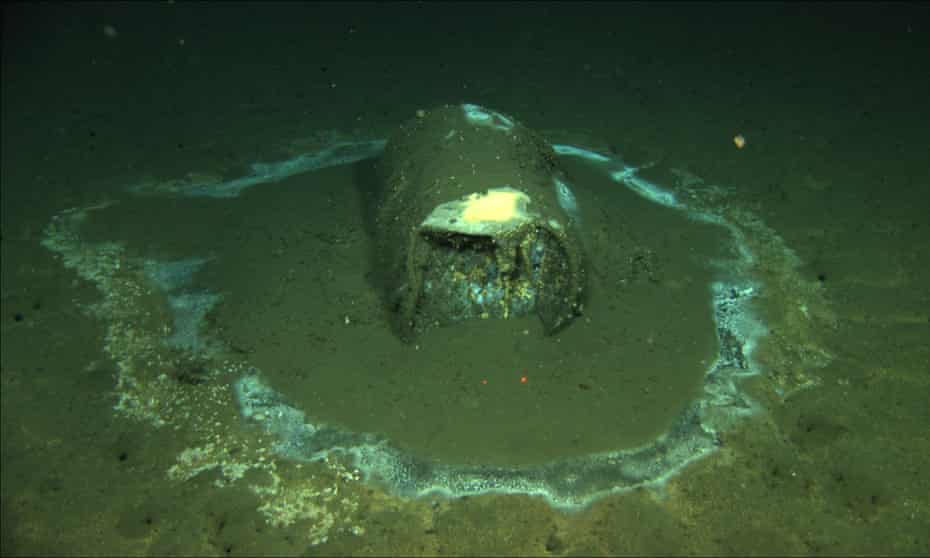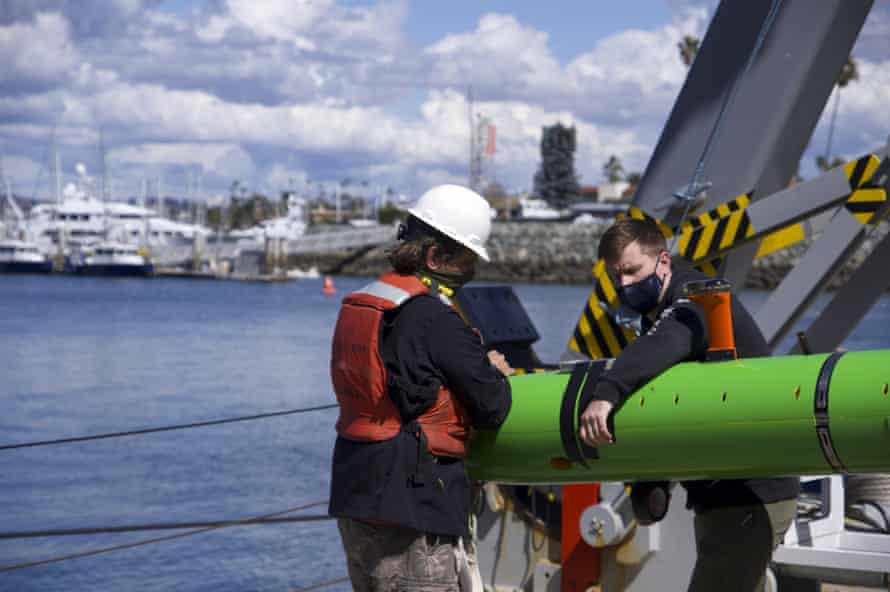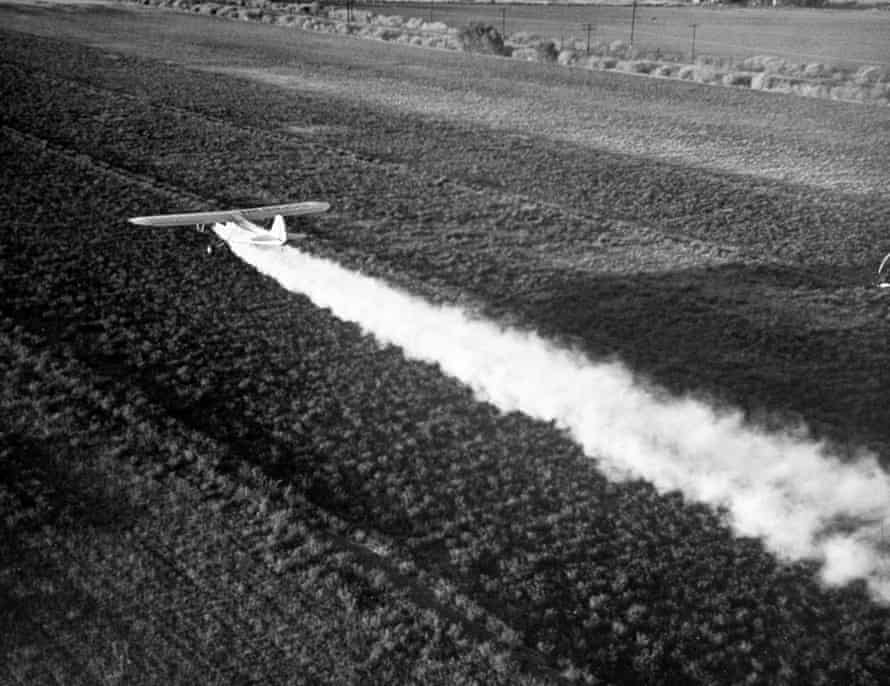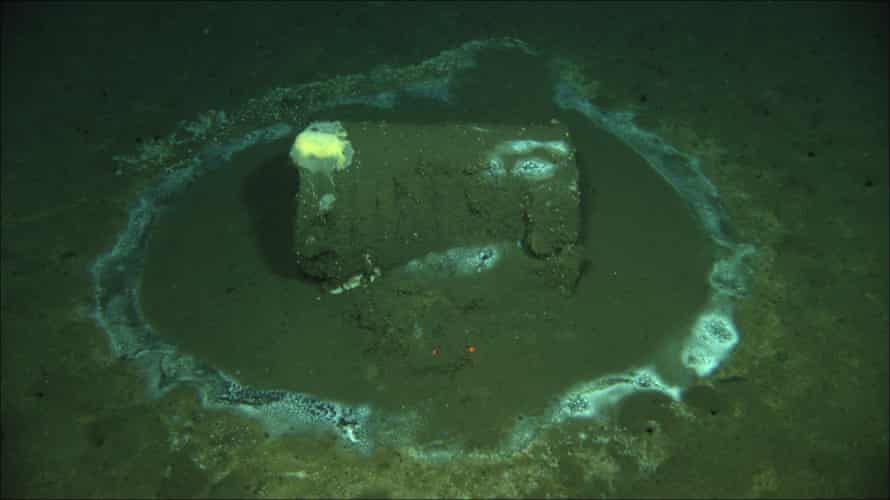California’s legacy of DDT waste: underwater dump site uncovers a toxic history
Aaron Miguel Cantú The Guardian, 30 Apr 2021

A barrel containing what scientists believe to be DDT waste sits on the ocean floor near the coast of Santa Catalina Island, California.
Photograph: David Valentine/AP
The discovery of tens of thousands of underwater barrels containing what scientists believe to be chemical waste has raised alarm and reopened scrutiny into a history of toxic dumping that persisted off the California coast into the 1970s.
A team of scientists announced this week that they had found more than 25,000 containers, many of which they believe to be DDT waste, which has been linked to cancer and disease in humans and mass die-off events in the natural world. The barrels cover a seafloor area double the size of Manhattan off the coast of the Santa Catalina Island, near Los Angeles.

Read more from The Guardian news service (and please support their fine work – editor)
The expedition was the first of its kind to lay bare the scale of the offshore dumping that occurred for decades, and its size “was a surprise to everyone who has worked with the data and sailed at sea”, said Eric Terrill, the chief scientist of the expedition and director of the Marine Physical Laboratory at Scripps Institution of Oceanography, at a press conference about the findings. “As we started to run the survey on the seafloor, it was staggering to see the extent of the dumping of what we suspected was DDT.”
Scientists who spoke with the Guardian expressed shock at the extent of the dump ground. And hopes about the innovative technology used to map out the area is tempered by looming questions about what to do about the waste – not just off the coast of Los Angeles, but in sea waters across the country that various industries treated as a cheap alternative to landfills for decades.
“It’s frustrating, it’s shocking, but probably isn’t that surprising at the end of the day,” said Rainer Lohmann, a professor of oceanography at the University of Connecticut who studies persistent organic pollutants in the environment and who was not part of the survey team. “I think if we had the money and sense of purpose, we’d find a lot more of these sites, but the question is what do you do with these corroded waste dumps?”

Researchers aboard the Sally Ride recover an autonomous underwater vehicle after a search for discarded barrels near Santa Catalina Island, California. Photograph: AP
For David Valentine, a professor of Earth science and biology at the University of California, Santa Barbara, who stumbled upon the presence of dozens of barrels leaking toxic waste in this region a decade ago, the discovery raises a host of new questions about the role of scientists in remediating ocean damage from industrial waste.
“I see steps to take to get us to a point where we can make informed decisions, but we’re nowhere near the ability to make informed decisions because we don’t know what’s there, we don’t know what’s in these barrels, these are what I call operationally important uncertainties – we need to figure that out.”
Decades of dumping
While the recent expedition did not sample sediment around the barrels, their location tracks with historical records from a 20th-century chemical company reported to have dumped DDT waste in the region for decades.
Dichloro-diphenyl-trichloroethane (DDT) is a highly toxic insecticide that was once used in abundance throughout the US, primarily as an agricultural pesticide. It was also sprayed in generous quantities at beaches and other public areas in order to kill mosquitoes as well as pests inside buildings.
DDT was later discovered to be disruptive for mammalian hormonal systems, appearing to induce breast cancer in women and testicular cancer in men and other deleterious health effects. DDT’s use was eventually banned in the US in the 1970s, although it is still used to kill mosquitoes in Africa with high rates of malaria infection.
The southern California city of Torrance, north of Santa Catalina Island, was once the center of DDT production in the US. The insecticide was produced there in massive volumes after the second world war up through 1982 by the Montrose Chemical Corporation.

A plane spraying alfalfa fields with DDT in California’s Imperial Valley in 1947.
Photograph: Loomis Dean/Time & Life Pictures/Getty Image
Throughout the life of the plant, Montrose contracted with the California Salvage Company to dispose of up to 2,000 barrels a month of acid sludge waste containing DDT by dumping it in the waters off the coast in the San Pedro Basin, between the Palos Verdes shelf and the Santa Catalina Island region, before modern environmental laws banning such dumping were passed by Congress. Workers sometimes took an axe to the barrels so they would fall to the seafloor faster, probably causing them to leak chemicals as they sank.
Interest in the matter has ebbed and flowed since. The latest mission was prompted in part by a story in the Los Angeles Times last year about the presence of up to half a million barrels of DDT that had been dumped off the coast.
The two-week survey was conducted by a team from the Scripps Institution of Oceanography at University of California, San Diego, in collaboration with the National Oceanic and Atmospheric Administration (NOAA).
The mission was the first of its kind to use seafloor robots, sonar acoustic imagery and data analytics to map out in fine detail the tens of thousands of barrels thrown into the ocean by workers decades ago.
In total, the scientists detected 27,345 objects they classified “with a high degree of confidence” as barrels and identified more than 100,000 items of manmade debris across the survey area. The robots, which scientists pre-programmed from the ship before placing them in the water, fanned out autonomously across the seafloor that reached depths of 3,000 feet. The robots had sensors on both sides that scanned the seafloor at lengths of between 150 and 200 meters.

Scientists detected as many as 25,000 barrels on the seafloor. Photograph: David Valentine/AP
The imagery produced by the robots’ sonar detection looks like thousands of tiny white dots that appear mostly in linear track lines, a sign that the barrels may have been dumped from moving ships. Some of the track lines were as long as 11 miles and appeared to extend from the port of Long Beach, according to Terrill. The barrels also appeared to extend beyond the boundaries recorded by the Montrose Chemical Corporation.
“It’s these linear patterns that splay out from [Long Beach] port area that tell us about the actual behavior they were engaging in,” said Valentine, “towing a barge, going in a straight line, and just dump, dump, dump, dumping it off the back, so you end up with these long lines of waste barrels on the seafloor.”
Representatives for the Montrose Chemical Corporation did not respond to a request for comment about the scientists’ findings before publication.
The survey, conducted by a team of 31 scientists onboard a research vessel owned by the US navy, is by far the most expansive investigation in the US of industrial waste dumping in a single area. While high volumes of DDT are known to have been dumped here, Terrill said that a number of other waste chemicals were also disposed of in the region, including acid sludge waste from the oil and gas industry, according to historical records.
Generations of toxic impact
The US banned DDT’s application in 1972, one of the earliest and most consequential decisions taken by the nascent Environmental Protection Agency (EPA). Yet the evidence of its toxic impact and long-lasting effects is still coming into full view.
A recent study by scientists at UC Davis and the Public Health Institute in Oakland found that the granddaughters of women poisoned by DDT are still suffering from its effects, including a higher likelihood of obesity and very early onset of menstrual periods. Other health effects continue coming to light, including links to Parkinson’s disease and Alzheimer’s.
The effects of DDT on animals are also devastating, and not exclusive to marine life in California. By the 1970s, scientists were already aware that the highly stable chemical was affecting animals up the marine food chain, from zooplankton to pelicans to sea lions, and leading to a mass die-offs of bees and insects. Near the Great Barrier Reef off the coast of Australia, DDT has been found in the tissues of snubfin dolphins and humpback dolphins. DDT has also been found in the blubber of bottlenose dolphins in southern California.
Off the coast of central California, another area known to have been a dumping ground for DDT and other industrial chemicals, a 20-year-long study that examined tissue samples of 394 living sea lions discovered a link between exposure to contaminants and high rates of herpes and cancer among the animals.
Dr Francis Gulland, a research associate at UC Davis who helped conduct the research while working as a veterinarian at the Marine Mammal Center in Sausalito, says that sea lions that had both herpes and exposure to contaminants were most likely to develop cancer.
“Given that the sea lions are exposed in the uterus to the contaminates, they could be altering the surface of the reproductive tract so it’s easier for the herpes virus to bind and re-infect them, or it could be a marker of an unknown carcinogen.”

Harbor seals laze at the base of the breakwater in San Pedro Bay, off the coast of Long Beach. Photograph: Robyn Beck/AFP/Getty Images
Back in the 1980s and 1990s, ocean dumping in southern California had mostly escaped the scrutiny that officials detected at the former Montrose Chemical Corporation plant, which was designated a federal Superfund site in 1989. The plant discharged wastewater containing significant concentrations of DDT to local sewers that emptied into the Pacific Ocean from the Palos Verdes peninsula.
But when Valentine’s team at UC Santa Barbara collected sediment from the ocean floor in 2011 and again in 2013, they found concentrations of DDT that was 40 times higher than the maximum quantities measured at the Superfund site.
The Santa Barbara team’s initial survey of 60 barrels formed the basis of the algorithm that the UC San Diego Scripps team used last month to model the potential size of individual barrels, which were only about three feet high and too small to detect without recent technological advances, according to Sophia Merrifield, an assistant researcher at Scripps who led the data science portion of the mission.
In order to detect the barrels, “we needed to be able to pump hundreds of gigabytes into an algorithm to detect these very small, very bright targets”, Merrifield said.
Terrill, the scientist who led the barrel detection effort, said that he hoped other scientists would now have a firmer idea of where to collect sediment to test for DDT and other chemicals in order to gauge the extent of contamination. The research team is also in discussions with public officials to publicly disseminate all of the data the team collected.
“Our goal is to inform the scientific community & the chemical manufacturers to develop a strategy for how to respond to what we discover,” Terrill said.
The solution? ‘We just don’t know’
Some theoretical solutions to the waste, such as removing the barrels or containing them with cement structures, would be astronomically expensive and perhaps not even feasible. Mitigation of future harm may be among the few options available, according to Lohmann, the scientist at the University of Connecticut.
“One thing to do would be to limit commercial activity in that region, to not disturb the site any more and cause additional damage or break open the barrels,” Lohmann said, “and to stop producing chemicals that are harmful and don’t go away any time soon.”
For Valentine, the next logical step for scientists is to understand all the ways DDT and other toxic waste dumped into the ocean are altering the marine environment.
“We don’t know how much of this material is being naturally decomposed in micro-organisms in the sediment, we don’t know how quickly it might be buried in the geological strata,” Valentine said. “We just don’t know enough to answer those questions, and I think we need concerted effort from the scientific community with support from the federal and state government to address those things and help build our knowledge base and define those goals.”